Serving a dessert-only tasting menu is one of the most fascinating cooking challenges of the last two decades. But dessert restaurants face a difficult existence. At the beginning of the millennium, when Ferran Adrià urged his young colleagues to break the wall the French had erected between sweet and savoury, they seemed to be rampant. Desserts, pioneers like Jordi Butron (Espai Sucre, Barcelona) and Will Goldfarb (Room 4 Dessert, New York and now in Bali) demonstrated, may well bypass the ghetto of the end of the meal to support it, from start to finish. But something must have gone wrong if these same restaurants have struggled to stand out. If they have remained almost completely isolated examples, with very few emulators.
This is what we think as we cross the threshold of a Berlin restaurant camouflaged among the trendy districts of Neukölln and Kreutzberg. Amidst the dark lights and diffuse hubbub, we meet its smiling founder René Frank. Almost 39 years old, this young man from Baden-Württemberg was shaken by a rare electricity even as a kid: he immediately set off to learn the art of pastry-making in important establishments in Spain, France, Japan and the United States, and then won three Michelin stars as head pastry chef of La Vie restaurant in Osnabrück.
In 2016, his solo adventure began: Coda is an Italian word tail but also for a rhythm, a melody. At the tail end of something. With partner Oliver Bischoff, the initial intention was to open a simple dessert bar, but Frank is so curious, gifted and precise (a control freak, he says of himself) that the establishment is rewarded first with one (2018), then with two Michelin stars (in February 2020, with Covid approaching). And in 2022 comes another title that boosts his popularity: he is nominated 'World's Best Pastry Chef' by the jurors of the 2022World's 50Best.
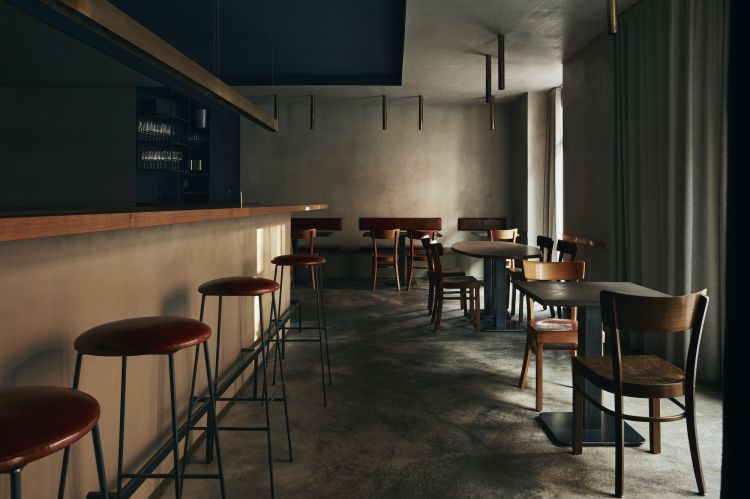
The tables and counter at the entrance of Coda, seat around 30 people for an average of 3 hours. Fun fact: the tasting menu costs 244 euros on weekdays (288 euros if one wishes to add the caviar icicle, see below) and 30 euros more on weekends. 'Even restaurants need to adapt to demand'. Photo by Claudia Goedke
Beware, however, Renè Frank is not a laboratory pastry chef, but someone profoundly different: he is a restaurant pastry chef who has become the integral chef of a restaurant serving express dishes, transferring his rigorous approach to each course. 'We are not a restaurant that serves desserts,' he is keen to specify, 'but a restaurant that tries to apply the best techniques of the pastry art to the kitchen.' As he explains the concept, we are captivated by an unusual detail: at the pass, head chef Julia Leitner lines up six precision scales. Weights, times and temperatures for the utmost attention to details. Isn't this what makes pastry making a different art from cooking? Shouldn't it be, cooking tout court, more and more precision and less and less improvisation? Shouldn't we increasingly blur the line between two arts that have long been kept unduly separate?
In the hubbub of a never-so-high volume for a two-star, Frank intervenes with an important concept, very Asian and not very European: 'I learnt the greatest lesson from the Japanese: the obsession to do the same thing over and over again to the point of exhaustion, the progressive approach to perfection. There is no such thing as perfection, but it is better to behave as if it were a real goal, like the god of bets Blaise Pascal: methodologically, there is only to be gained. The opposite of Western cuisine's terror of repetition, always on the hunt for something new, for endless reset and restart.
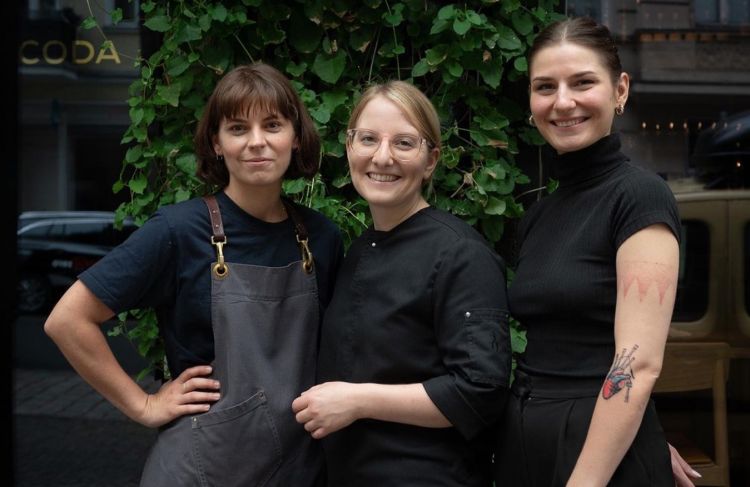
Three pillars of the Coda restaurant: left to right, Sophia Fenger (sommelière), Julia Leitner (head chef, Austrian) and Elise Czako (restaurant manager). Photo by Claudia Goedke
So Coda's tasting menu is a sequence of 15 steps, many of which are intertwined with ingredients that were created at the beginning (parsley root, see the
below) but perfected, refined, transmuted over time. No refined sugars, milk or butter but only natural sweetness. 'Sweet and umami, to be exact,' Frank lightens up, 'two flavours we love since our mother's breastmilk'. Hence all the caramelisation, reductions, concentrations, multiplication of textures. And the always open dialogue with the savoury, the sour, the bitter. In the larder there are no industrial semi-finished products but vegetables, cereals, dried fruit and herbs: wheat and rice, beetroot, aubergines and carrots, walnuts and almonds, some small fermentations. And very little milk and butter, meat and fish, in a quasi-vegetarian 'dessert' menu, always careful not to exceed the sum of calories. All this with the precise geometric shapes of pastry: round and elliptical shapes prevail in tartes, biscuits, sorbets and ice cream. Is this a syncretism of a fine dining to come?
CODA, tasting menu, 28th September 2023 (photo by Zanatta)
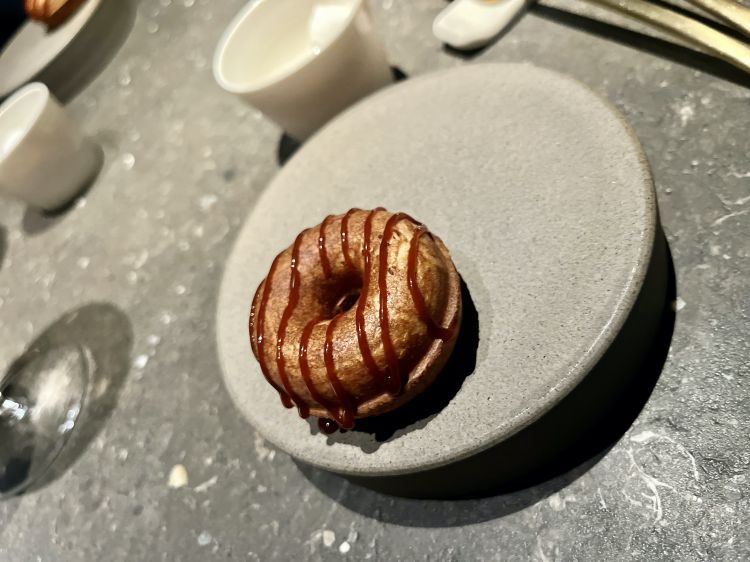
Brioche
After two small appetisers (golden beetroot Gummy bears and a sweet potato and almond Beefcake), we get into the heart of the tasting menu with a Brioche with rice flour dough and a rather soft texture. It is filled with a delicious Gouda cow's milk cheese (very popular in the Netherlands), aged 6 months and sprinkled with turnip caramel at the table. Delicious
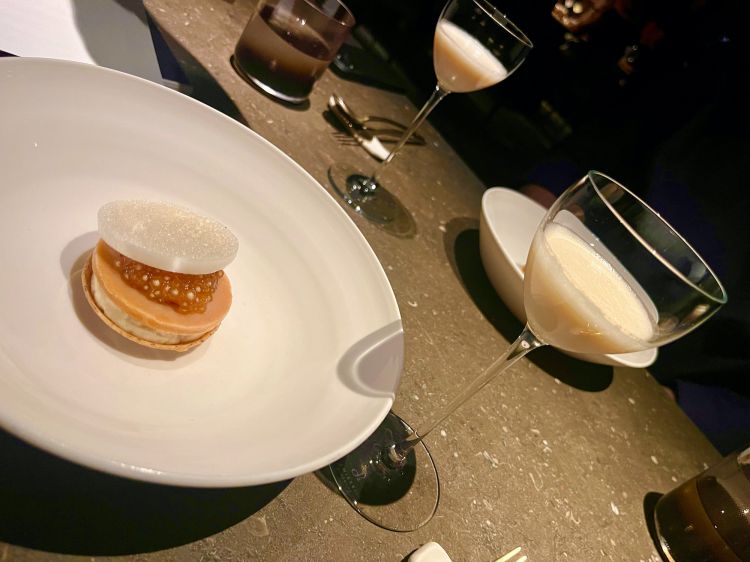
Yellow tomato
The tomato is served in two steps: dehydrated, sorbet-like, and confit. The chickpeas are in mousse and meringue form (the ethereal top part). Finished with lemon. It is served alongside a shot of apricot brandy, toasted coriander seeds and homemade almond milk. As complex and surgical as the food, the beverage component dialogues very well with the edible part
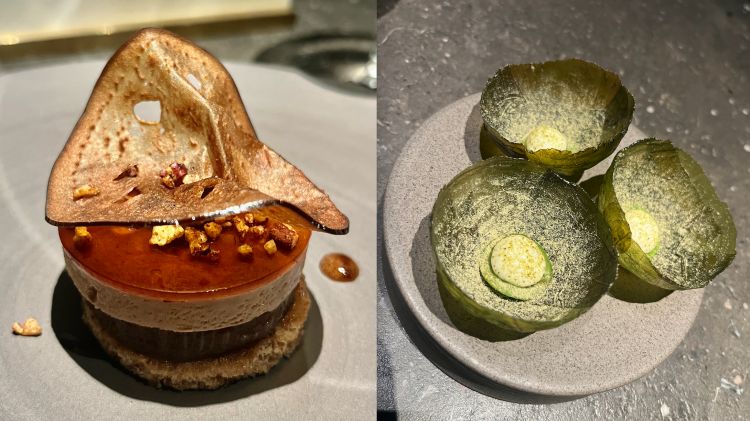
Aubergine and Lettuce
To the left, aubergine with pecans, cider vinegar and liquorice salt, another Coda classic. To the right, a small ethereal shell of candied lettuce with cream cheese and gherkin powder
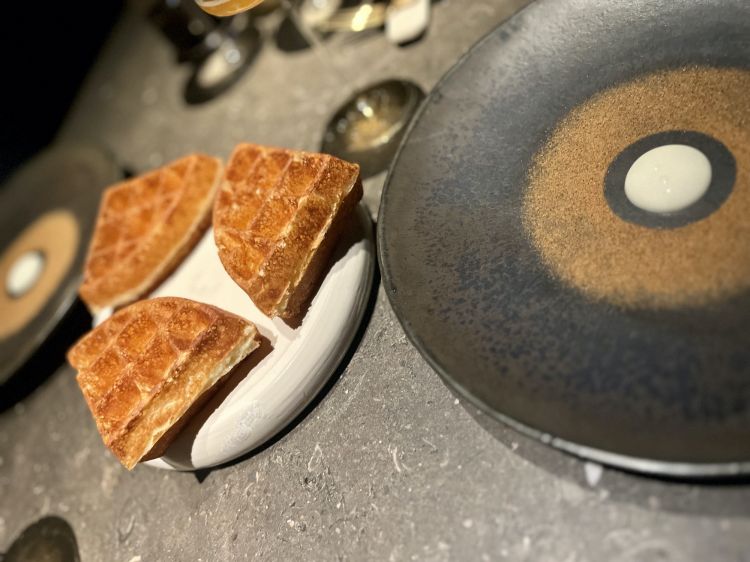
Raclette Waffle
A mouth-watering waffle filled with cheese, to be broken with your hands and dipped in a rather sour yoghurt drop, enhanced by the pungent notes of dehydrated kimchi powder
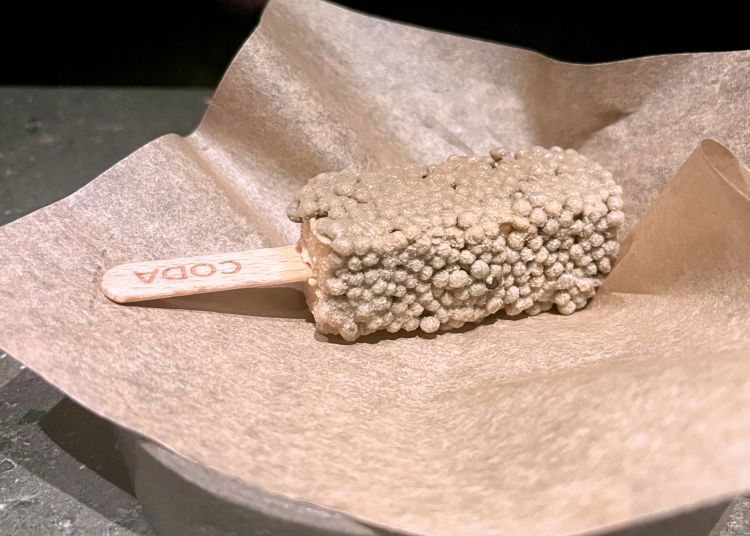
Caviar icing
Coda's signature dish is made with Osietra caviar of French origin (Sturia, Aquitaine) covered in chocolate, on vanilla and Jerusalem artichoke ice cream and a pecan ganache at the heart, before the stick. The concept (rich and popular, high and low) reminded us of Massimo Bottura's foie gras magnum
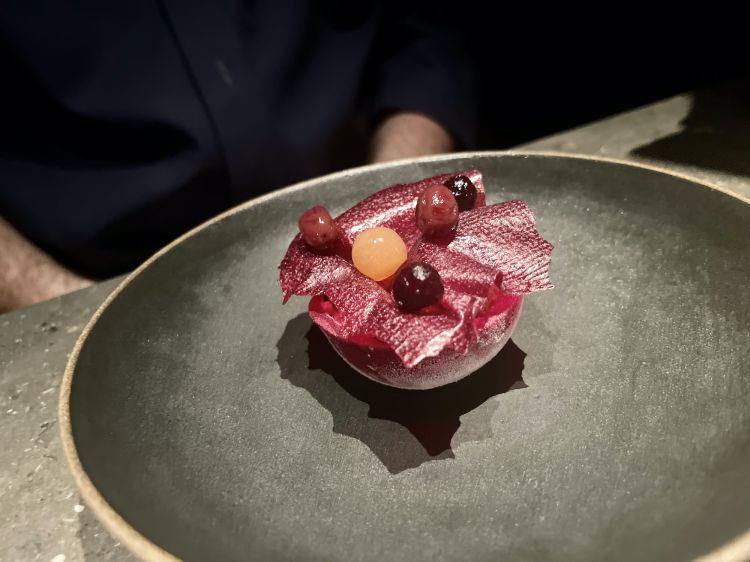
Frozen beetroot
Beetroot sorbet made from the reduced and concetrated vegetable. On top, crispy dehydrated beetroot. Verjus (unripe vegetable juice) jelly and whipped tofu. Another sweet, vegetable, humamic tartlet
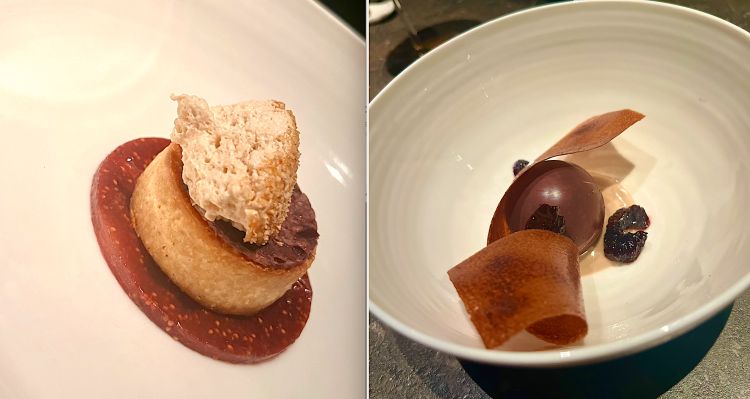
Dike cheese and cocoa tartlet and crunchy
To the left, Dike cheese tartlet, figs confit and, above, whipped peanut cream and marrow. Dike, in German deich, means 'dam': deichkäse , 'dam cheese'. It comes from a dairy farm near the North Sea, in the Friesland region, where cows graze. The ageing cells (the ageing lasts one year) are located right under the dykes: the microclimate and proximity to the sea give important saline notes
Right, a chocolate mousse with caramelised soya milk, semi-dried cherries and preserved cherry sauce.
An interesting interlude is served between the two dishes: breadsticks of caramelised pork rind, sauerkraut powder and pear puree
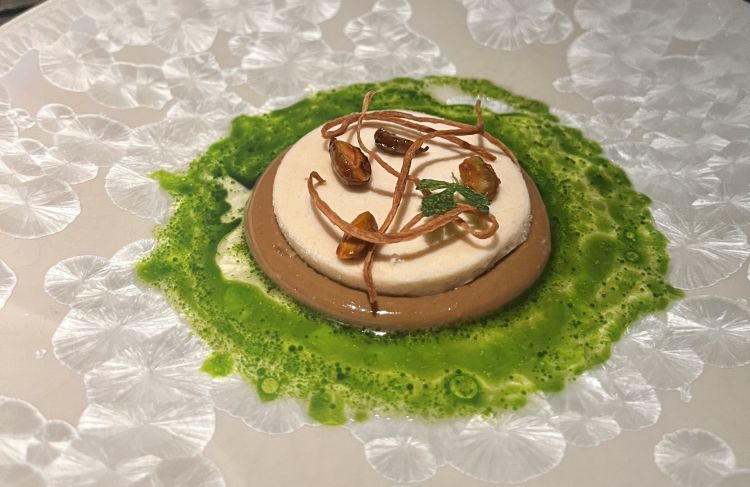
Parsley root, black garlic and pistachio
Cream of black garlic (with deep notes of cocoa and coffee, the result of the fermentation process), parsley root ice cream, caramelised pistachio and a vinaigrette of parsley leaf oil and lime, served at the table. It is among Coda's longest-lived dishes and also the one that impressed us the most with its unexpected result (acidity, roundness, herbaceousness, freshness), after the pre-tasting scepticism
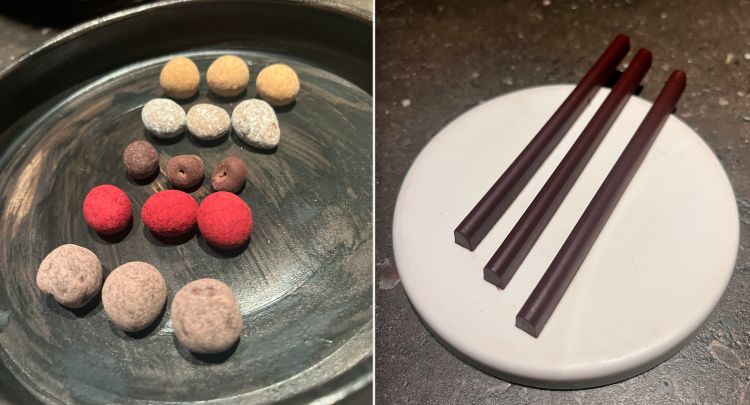
To close the meal, a great variety of pralines and inventiveness and chocolate strips (crispy outside and liquid inside)
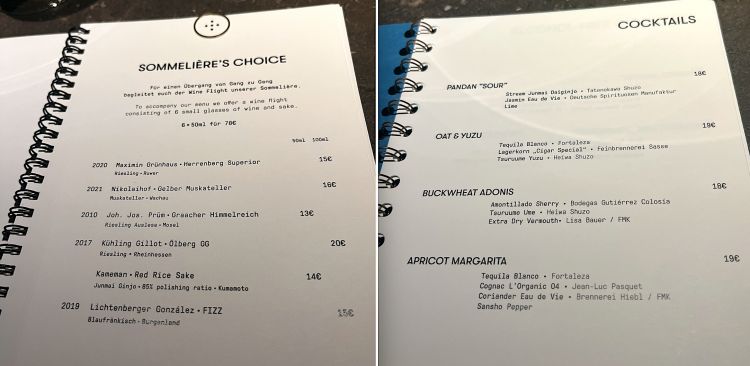
Left, the beverage pairings with the tasting menu: all German wines (the list is 80% German wines, including Rieslings with a great depth of vintage) and a sake. Right, a cocktail proposal for the end of the meal
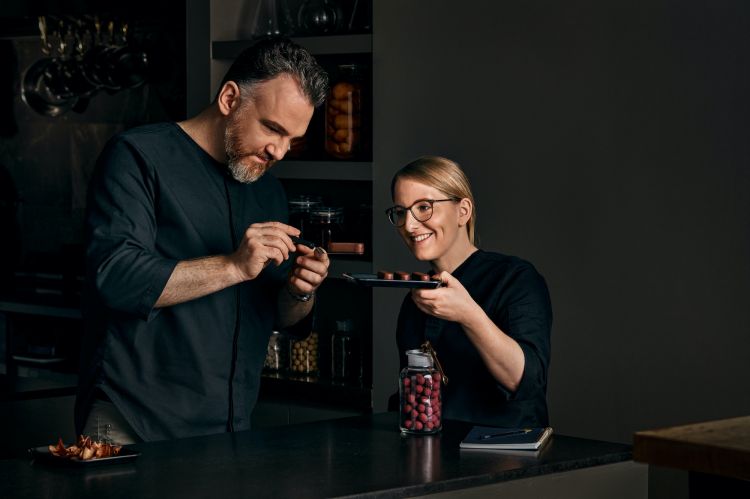
René Frank and Julia Leitner. Photo by Claudia Goedke
Translated into English by Slawka G. Scarso